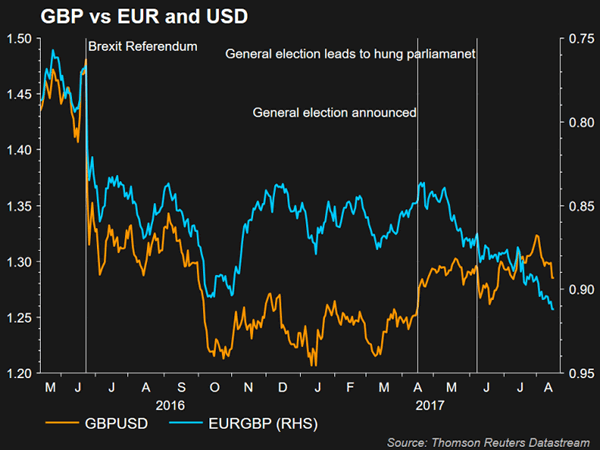After being criticised by EU officials for turning up at the negotiating table unprepared, the UK has this week published its most comprehensive vision yet of a post-Brexit relationship with the bloc. The British government published yesterday its first policy paper on a future customs agreement with the European Union, and is due to soon release a paper on Northern Ireland and its border arrangements with the Irish Republic.
The paper calls for a new customs partnership with the EU with the aim of achieving "as frictionless as possible" trade between the UK and the EU. Aside from the desire to maintain a barrier-free trade with the EU, the British government wants to avoid a return to a hard-border between Northern Ireland and the Republic of Ireland as this could jeopardise the Peace Process in the province. Also outlined in the paper are proposals for an interim arrangement for a "time-limited period" to allow UK businesses to adjust to the new customs agreement once Britain is out of the EU.
The proposal for an interim customs system is a welcome relief for the UK business community who feared a cliff-edge scenario when the prime minister, Theresa May, raised the prospect of a ‘hard Brexit’ in her first major speech on the UK’s exit plans back in January. Signs that the government is now shifting towards the idea of having a transitional agreement in place once the UK leaves the EU in March 2019 have helped the pound move towards 10-month highs against the US dollar, rising above $1.32 earlier this month.

The turnaround came after the Prime Minister lost her parliamentary majority in June’s snap election, which had the opposite intention of strengthening her negotiating hand in what proved to be a major political misjudgement. Many blamed the Conservatives’ poor performance in the election on the government’s hard line on Brexit, with the shock vote outcome giving an unexpected boost to the Remainers within May’s cabinet, notably, the finance minister, Philip Hammond.
Amid all the political headlines, a more hawkish Bank of England has also lifted the pound, as surging import costs, brought on by sterling’s post-Brexit depreciation, pushed UK inflation to near 4-year highs in May. However, CPI has eased back to 2.6% in June and July, alleviating some of the pressure on the Bank to act sooner rather than later.
The pound slipped back below the $1.29 level after this week’s July inflation data, but more crucial will be Thursday’s retail sales figures. Annual retail sales have moderated significantly in 2017 compared to last year. Household consumption comprises around 65% of UK GDP and a slowdown in spending would have a significant impact on growth, especially as so far, the weaker pound has not provided much of a boost to exporters. Rising exports and a subsequent increase in business investment has the potential to offset any decline in consumer spending.
A persistent weakness in consumption would mean the UK economy will likely continue growing at around the sluggish rate of 0.2-0.3% seen during the first two quarters of the year. This would make it more difficult for the BoE to raise rates when growth is so low and the economy vulnerable to Brexit developments. Without a rebound in consumer spending in sight, sterling could further reverse some of its impressive gains made since April.
Not all data has been feeble however, with the UK labour market remaining robust. Figures released today showed the jobless rate fell to a 42-year low of 4.4% in the three months to June. Wage growth also came in above expectations, picking up to 2.1% during the same period (though this is still below the rate of inflation). Further gains in earnings growth would be viewed as being positive for higher consumer spending and would ease concerns of a prolonged downturn in consumption.
It would also give more weight to the hawkish voices within the BoE’s Monetary Policy Committee. With more MPC members becoming uncomfortable with inflation running above their target, the Bank may feel confident enough to overlook the current soft patch in the economy and raise rates on the expectation that higher wage growth will keep CPI running above 2%.
The constantly altering outlook for UK rates has become a bigger factor driving the pound in recent weeks, with the UK currency becoming less sensitive to the Brexit negotiations. However, it is too early to rule out further big political shocks causing disruption in the forex markets as no conclusive agreement has yet to emerge from the Brexit talks, while Theresa May’s future in Number 10 looks highly uncertain and another fresh election plausible.
In the meantime, the broader dollar weakness and the resurgent euro have also influenced the outlook for the pound, particularly the single currency, which has risen to 10-month highs of above 0.91 pounds this week. Morgan Stanley projected last week the euro would hit parity with the pound in 2018, though other forecasts are a bit more bullish for sterling. Some analysts see the euro rally as overdone as the excessive rise in euro/dollar is not supported by a corresponding increase in either the short- or long-term yield differentials between US and German government bonds, suggesting the moves are mostly speculative.
According to the latest Reuters poll, forecasts for pound/dollar during Q3 2017 and Q2 2018 range between $1.15 and $1.44, while for euro/pound they stand between 0.77 and 1.03 pounds. For now though, the pound remains well supported above $1.26, but may struggle to climb past $1.33 without a fresh breakthrough in the Brexit negotiations or signs that the UK economy is gaining traction.












